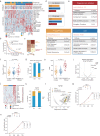Proteogenomics of clear cell renal cell carcinoma response to tyrosine kinase inhibitor
- PMID: 37460463
- PMCID: PMC10352361
- DOI: 10.1038/s41467-023-39981-6
Proteogenomics of clear cell renal cell carcinoma response to tyrosine kinase inhibitor
Abstract
The tyrosine kinase inhibitor (TKI) Sunitinib is one the therapies approved for advanced renal cell carcinoma. Here, we undertake proteogenomic profiling of 115 tumors from patients with clear cell renal cell carcinoma (ccRCC) undergoing Sunitinib treatment and reveal the molecular basis of differential clinical outcomes with TKI therapy. We find that chromosome 7q gain-induced mTOR signaling activation is associated with poor therapeutic outcomes with Sunitinib treatment, whereas the aristolochic acid signature and VHL mutation synergistically caused enhanced glycolysis is correlated with better prognosis. The proteomic and phosphoproteomic analysis further highlights the responsibility of mTOR signaling for non-response to Sunitinib. Immune landscape characterization reveals diverse tumor microenvironment subsets in ccRCC. Finally, we construct a multi-omics classifier that can detect responder and non-responder patients (receiver operating characteristic-area under the curve, 0.98). Our study highlights associations between ccRCC molecular characteristics and the response to TKI, which can facilitate future improvement of therapeutic responses.
© 2023. The Author(s).
Conflict of interest statement
The authors declare no competing interests.
Figures







References
Publication types
MeSH terms
Substances
LinkOut - more resources
Full Text Sources
Medical
Miscellaneous

